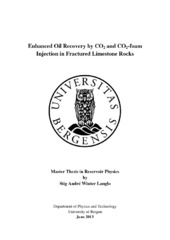Enhanced Oil Recovery by CO2 and CO2-foam Injection in Fractured Limestone Rocks
Master thesis
Permanent lenke
https://hdl.handle.net/1956/6781Utgivelsesdato
2013-06-03Metadata
Vis full innførselSamlinger
Sammendrag
This thesis is part of an ongoing study of integrated enhanced oil recovery methods in Reservoir Physics group at the Department of Physics and Technology at the University of Bergen. This experimental thesis investigates through laboratory tests the miscible, liquid CO2 injection for enhanced oil recovery in an outcrop limestone rock, analogue to carbonate reservoirs. A total of 18 CO2 injection experiments have been performed to study the influence on CO2 EOR from parameters such as presence of fractures, presence of initial water as irreducible water saturation, wettability preference of the matrix, injection of foam for mobility control, and comparing secondary to tertiary recovery. Core plugs were artificially fractured by cutting the cores along the length of the core. A spacer was placed in the fracture to maintain a constant aperture and identical fracture permeability between tests. As a part of the thesis, experimental setups were designed and built to be able to inject CO2 at elevated pressures over 90bars to develop miscibility between CO2 and the oil phase (n-Decane). Results from laboratory tests show that CO2 has a significant recovery potential in whole and fractured limestone core plugs, with total recoveries ranging from 92-100 % OOIP for fully oil saturated cores, and 75-92 % OOIP for cores with irreducible water saturation. The presence of fractures dramatically reduced the rate of oil recovery, where oil recovery was mainly driven by diffusion, with negligible viscous displacement. The presence of water, either as initial irreducible water saturation, or after a waterflood reduces the total oil recovery and reduced the rate of oil recovery. In fractured core plugs, the injection of CO2-foam accelerated oil recovery compared to pure CO2 injection by adding a viscous displacement in addition to diffusion. The oil recovery rate was also increased during a Huff 'n' Puff scenario compared to continuous CO2 injection. Moderately oil-wet cores demonstrate a higher total oil recovery than water-wet cores for both pure CO2 and CO2-foam injection. During CO2-foam injection, differential pressure is higher near the end of production, indicating that oil has a detrimental effect on foam. Numerical simulations have been performed with CMG GEM simulator to study liquid CO2-injection in a fractured system, and the simulations were able to satisfactory reproduce the experimental data. The validated numerical model should be used further for increased understanding, for better depth of analysis, and to reduce time usage compared to advanced, time-consuming experimental work. The results from this thesis show the potential for CCUS in fractured carbonate reservoirs. Even though the oil recovery rate is reduced with fractures, the total oil recovery is still high and diffusion can be an effective recovery mechanism. It is important to note that oil recovery on a reservoir scale will be reduced compared to oil recovery on core plugs.
